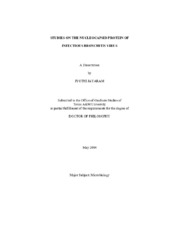| dc.description.abstract | Because phosphorylation of the infectious bronchitis virus (IBV) nucleocapsid (N) protein may regulate its multiple roles in viral replication, the dynamics of N phosphorylation were examined. In the infected cell, N was the only viral protein that was phosphorylated as shown by 32P-orthophosphate labeling and Western blot analysis and with IBV specific polyclonal chicken antibody. Using pulse-labeling with 32Porthophosphate, the IBV N protein was found to be phosphorylated in the virion, as well as at all times during infection of Vero cells. One-hour pulse-chase analysis followed by immunoprecipitation of IBV N using rabbit anti-IBV N polyclonal antibody showed that the phosphate on the protein did not fall below 70% of the maximum and remained stable. The small but reproducible drop in phosphorylation could modulate the various functions of the N protein in the infected cell. Simultaneous labeling with 32Porthophosphate and 3H-leucine of infected CEK cells indicated a 3.5-fold increase in the ratio of the 32P:3H counts per minute (cpm) on the virion N protein as compared to the 32P:3H cpm ratio of the N protein from lysates at 7 h p.i. The 32P:3H cpm ratio of the N protein from virion from infected-Vero cell lysates was 10.5X more than the 32P:3H cpm ratio of the N protein obtained at 7 h p.i. It has been shown that the N proteins from the measles and rabies viruses form helical nucleocapsid-like structures when expressed in bacteria (Schoehn et al., 2001; Warnes et al., 1995). The ability of E. coli expressed IBV N protein to form helical-nucleocapsid-like structures was investigated using transmission electron microscopy. Full-length, purified histidine-tagged IBV N protein formed nucleocapsid-like structures when expressed in bacteria. Because E. coli -expressed histidine-tagged fragments of the IBV N protein did not form helical nucleocapsid-like structures, the full-length protein is probably required for assembly of these structures. The highly conserved IBV N protein was also used as a diagnostic tool in an ELISA for detecting anti-IBV antibody in chicken serum using a specialized microwave called the BIOWAVE. The BIOWAVE improves the processing time for an ELISA. | en |


